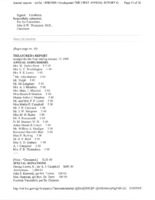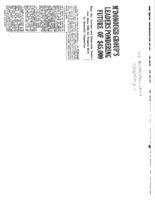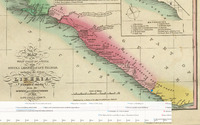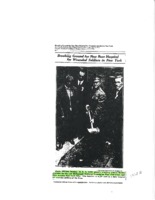mcdonogh
Item set
- Title
- mcdonogh
- Description
- All items
Items
-
 McDonough Reference Files Inventory An inventory of McDonogh materials available at Lafayette College Archives & Special Collections.
McDonough Reference Files Inventory An inventory of McDonogh materials available at Lafayette College Archives & Special Collections. -
St. Philip's Episcopal ChurchSt. Philip's Episcopal Church was originally founded in 1818 and became the first African American Epsicopal church in New York City. One of its original locations was on 31 Centre Street in New York City. It is now located on 208 West 134th Street. St. Philip's was lead in its early years by leading abolitionist, Rev. Peter Williams, Jr. The church continued to play a key role in the fight for civil rights for African Americans.
-
Abyssinian Baptist ChurchAbyssinian Baptist Church, the oldest black congregation in New York, was founded in 1808 by a group of African American and Ethopians that refused accept segragated churches. Along with their abolitionist efforts and fight for equality, the church was and still is highly involved in the African American community. Some of the churches notable pastors included Adam Clayton Powell Sr. and his son Adam Clayton Powell Jr.
-
Zion African Methodist Episcopal ChurchThe roots of the Zion African Methodist Episcopal Church (AME) trace back as far as the the late 1700s however the church was not recoginized until 1820. The recoginition of the church came at a time when more African Americans in New York were gaining their freedom. The AME Church made it their goal to end slavery in the south and racsim in the north. The church was also a stoping point in the underground railroad. Some of it's notable members include Sojourner Truth and Frederick Douglass.
-
Shiloh Presbyterian ChurchShiloh Presbyterian Church was founded in 1822 as the First Colered Presbyterian Church under the abolitionist Samuel Carnish. From its opening, the church was involved in abolitionist effort ranging from the underground railroad to boycotts on products that were produced by slave labor. Fellow activist, Henry Highland Garnet, was the third pastor of the church.
-
Plane Street Colored Presbyterian ChurchEstablished on May 1835. Was most likely the Church that David regularly attended.
-
American Missionary Association National OfficeThe American Missionary Association was originally founded in 1846 in Albany, New York. Its main goals were to abolish slavery, promote racial equality, and educate African Americans as well as promoting Christian values. This association was also responsible for the founding of anti-slavery churches. During the 1870s the national office relocated to 287 4th Avenue in New York City. The AMA was responsible for the founding of numerous schools and colleges including Fisk and Howard University.
-
Bethel African Methodist Episcopal ChurchWas organized in 1842 in a building on Greene Street with a group of 15 members. It has moved several times and eventually changed its name to St. James African Methodist Episcopal Church and moved to 90 Union Street and then to the present location at 588 High Street.
-
 Donations and Board of Managers Adding these pages of donations, shows how much the community contributed to the first hospital. The various sources of donations to the Mcdonough Hospital portrays how imperative a non-segregated Hospital was at the time.
Donations and Board of Managers Adding these pages of donations, shows how much the community contributed to the first hospital. The various sources of donations to the Mcdonough Hospital portrays how imperative a non-segregated Hospital was at the time. -
 McDonogh Group's Leaders Pondering Future of $45,000 This article outlined a lot of the information for the fund raising of the second hospital.
McDonogh Group's Leaders Pondering Future of $45,000 This article outlined a lot of the information for the fund raising of the second hospital. -
Attempts to Raise Funds for a Second HosptialVarious shareholders tried to accumulate funds to open a new hospital, especially in the eve of WWI. But due to lack of funds and a statement issued by the surgeon general, saying that "no more institutions of the type contemplated by the Mcdonogh group were needed by the army."; the hospital never opened.
-
City Closes First Hospital"New York City officialdom, however, was not satisfied with the standards maintained, and closed the hospital in 1900. The assets lay dormant for a decade."
-
First Hospital opensOpened in a section of the city called " Little Africa"; "The Hospital opens two new fields. The one is a hospital in which physicians, regardless of nationality, creed or color, can have clinical practice; the other is a training school in which our colored girls can learn to be professional nurses.
-
Formation of McDonogh Memorial Hospital AssociationDr. Peter Johnson, once a mentee under the direction of David McDonogh, co-founded the organization in hopes to bring high quality medical services to the urban poor in New York City. Its officers, along with Dr. Johnson, were Dr. T. S. Miller, vice-president; and Dr. W. M. Lively, Secretary.
-
Death of McDonoghMcDonogh dies after 44 years of practice.
-
Helped wounded during the Draft riots.During the draft riots in 1863, he did great service in tending the wounded as they were carried into the station house.
-
Opens an office at 213 Sulivan St, in a New YorkMcDonogh opens an office where he worked until he died.
-
Married ElizabethDavid married and started family
-
Held position at the Eye and Ear InfimaryAfter McDonough received his liscense to practice, his mentor secured an appointmentment for him at the New York Eye and Ear Infirmary.
-
Completion of studies at P&SMcdonogh completes his studies at the College of Physicans and Surgeons. However, he was not listed as actually attending the college and never received and actual degree.
-
Studies under John K. RodgersJohn McDonogh places David under John K. Rodgers to study at the Eye and Ear Infirmary.

 Historical map of Liberia
Historical map of Liberia Ground Breaking for the Second Hospital in 1918
Ground Breaking for the Second Hospital in 1918 The First McDonogh Hospital 1898
The First McDonogh Hospital 1898 Pictures for McDonogh medical career
Pictures for McDonogh medical career